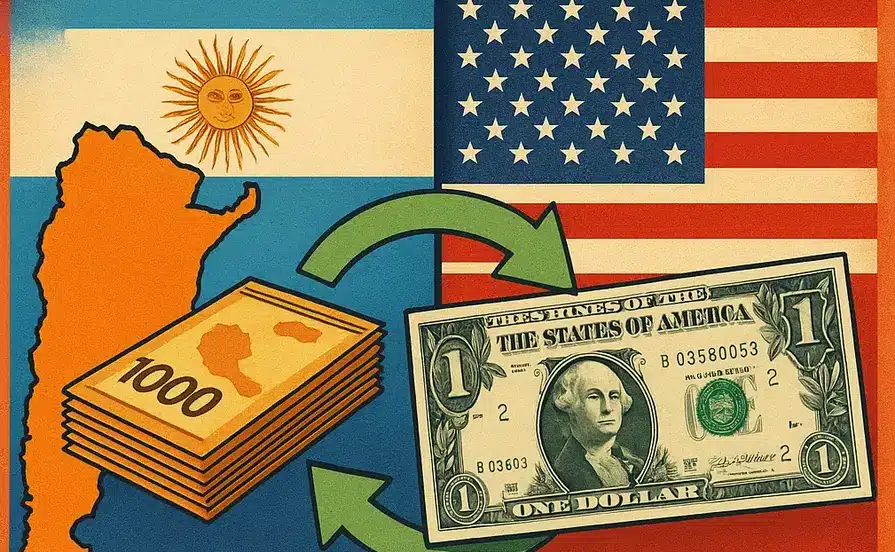The Argentina-US Dollar Swap Agreement has raised eyebrows across global financial markets. This isn’t just another economic assistance package—it’s a strategic move that reveals the Trump administration’s broader geopolitical agenda: using the dollar as a tool to “lock in dollar supremacy” while supporting ideologically aligned governments.
Why Argentina? The Geopolitical Calculus
The Unusual Choice
Argentina isn’t a major US trading partner. The bilateral trade between the two countries is a fraction of what exists with Mexico, Canada, or even Europe. So why Argentina? The answer lies in the Trump administration’s broader strategy of using the dollar as an economic weapon and geopolitical tool.
The “Dollar Supremacy” Strategy
According to Treasury Secretary sources, the overarching goal is to “lock in dollar supremacy” by facilitating swaps through the Treasury Department rather than traditional Fed-to-central bank arrangements. This approach has precedent—the Treasury Department used similar tactics during Mexico’s peso crisis in the mid-1990s.
Strategic Objectives:
- Maintain dollar dominance in global trade
- Support ideologically aligned governments
- Create economic dependencies that serve US interests
- Demonstrate the dollar’s role as the world’s reserve currency
What Exactly Is This Agreement?
The “Bridge” Metaphor
The Treasury Secretary described this as a “bridge to a better economic future” for Argentina—not a bailout. But the operative word is “bridge,” which implies something temporary that connects point A to point B. The critical question is: what’s the destination?
The Unknown Terms
What We Don’t Know:
- The exact amount of the swap line
- What Argentina has pledged as collateral
- The duration of the agreement
- The mechanisms protecting US taxpayers
- Whether banks have seen the actual agreement
Speculated Collateral:
- Argentina’s uranium reserves
- Preferential access to Argentine markets
- Future trade concessions
- Natural resource rights
The Multiple “Bridge” Scenarios in the Argentina-US Dollar Swap Agreement
Scenario 1: Political Timing
The swap could be a bridge until Argentina’s midterm elections on the 26th of this month. President Trump has already suggested that if Milei doesn’t win, the swap line will be removed.
Scenario 2: Currency Policy Change
It might be a bridge until Argentina abandons its peso peg, which the Minister for Deregulation and State Transformation suggested was “in the cards” during recent interviews.
Scenario 3: Resource Depletion
The bridge could last until the $20 billion runs out. Before the swap line, Argentina was burning through $1.5 billion in foreign currency reserves weekly.
Scenario 4: Economic Recovery
It might be a bridge until Argentina’s economy can support an exchange rate at current levels—something it certainly cannot do right now.
Scenario 5: Political Patience
The bridge could last until either President Trump loses patience or President Milei does something to annoy him.
The Economic Reality: Why This Is Problematic
The Unsustainable Peg
Argentina’s peso peg to the dollar is fundamentally unsustainable. The country’s economy cannot support the current exchange rate, making this more of a temporary lifeline than a sustainable solution.
Economic Challenges:
- Inflation control is critical for midterm elections
- Peso peg prevents natural currency adjustment
- Foreign reserves are being depleted rapidly
- Economic fundamentals don’t support current exchange rate
Market Response: Mixed Signals
The market’s reaction has been telling:
- Argentine bonds initially gained on the announcement
- Peso weakened to fresh lows despite the agreement
- Bonds have since given up gains and are posting losses
- Banks are struggling to navigate without guarantees
Short-Term Fix, Long-Term Risk
Argentina’s dollar peg may buy time, but it can’t rewrite fundamentals. Inflation, depleted reserves, and market mistrust reveal the limits of quick fixes. Sustainable solutions require structural reform, not temporary lifelines.
Explore Global Economic Insights →The Geopolitical Implications
Dollar as Economic Weapon
This agreement represents a new approach to using the dollar as a geopolitical tool:
Traditional Approach:
- Fed-to-central bank arrangements
- Market-driven currency policies
- Limited political interference
New Approach:
- Treasury Department facilitation
- Direct political control
- Ideological alignment requirements
- Economic weaponization
The Global Message
The Argentina swap sends a clear message to the world:
- The US will support ideologically aligned governments
- Dollar access is a privilege, not a right
- Economic assistance comes with political strings
- The US is willing to use its currency as a geopolitical tool
The Banking Sector’s Dilemma
Jamie Dimon’s Unprecedented Visit
JPMorgan Chase CEO Jamie Dimon’s visit to Argentina this week represents an unprecedented show of support for the government. However, banks are reportedly having difficulty navigating the arrangement without proper guarantees.
Banking Challenges:
- No clear collateral structure
- Unknown risk parameters
- Lack of transparency in agreement terms
- Potential for significant losses
The Intermediary Problem
Banks serving as intermediaries in this arrangement are operating in the dark:
- They don’t know what Argentina has pledged
- No clear understanding of US taxpayer protection
- Risk assessment is impossible without full terms
- Potential for being caught in the middle
Historical Precedent: The Soros Trade
The Bank of England Comparison
The Treasury Secretary’s involvement in the trade that broke the Bank of England in the early 1990s provides an interesting comparison, but with a crucial difference:
1990s Trade:
- UK had no backstop
- Market forces determined outcome
- Soros and Druckenmiller were on their own
Current Argentina Trade:
- Argentina has US backing
- Political considerations override market forces
- US taxpayer money at risk
The Risk Assessment: What Could Go Wrong?
For Argentina
Short-term Benefits:
- Temporary currency stability
- Political support ahead of elections
- Access to dollar liquidity
Long-term Risks:
- Increased dependence on US
- Loss of economic sovereignty
- Potential for sudden withdrawal of support
- Unsustainable economic policies
For the United States
Strategic Benefits:
- Demonstration of dollar power
- Support for aligned government
- Geopolitical influence
Potential Costs:
- US taxpayer exposure
- Reputation risk if agreement fails
- Precedent for future interventions
- Potential for significant losses
The Global Economic Impact
Dollar Dominance Reinforcement
This agreement reinforces the dollar’s position as the world’s reserve currency by:
- Demonstrating US willingness to support allies
- Creating economic dependencies
- Showing the dollar’s role in crisis management
- Establishing new precedents for currency intervention
Market Implications
Positive Signals:
- US commitment to global stability
- Support for market-oriented governments
- Demonstration of dollar strength
Negative Signals:
- Increased political risk in currency markets
- Potential for arbitrary policy changes
- Reduced market confidence in independent central banks
- Geopolitical weaponization of currency
The Transparency Problem
The “Ready, Aim, Fire” Approach
The swap plan appears to have been implemented with a “ready, aim, fire” approach:
- Agreement was put in place first
- Mechanics are being worked out after the fact
- No public documentation available
- Banks operating without full information
The Information Gap
What We Know:
- Agreement exists
- Treasury Department is facilitating
- Banks are involved as intermediaries
- Argentina has access to dollar liquidity
What We Don’t Know:
- Exact terms and conditions
- Collateral arrangements
- Duration and exit strategies
- Risk management mechanisms
- US taxpayer protection
FAQ Section
Q: Why is the US providing Argentina with a dollar swap line?
A: The US is using this as a strategic tool to “lock in dollar supremacy” while supporting an ideologically aligned government. It’s part of a broader strategy to use the dollar as a geopolitical weapon and maintain US economic influence.
Q: Is this really a bailout or just a bridge loan?
A: While the Treasury Secretary calls it a “bridge to a better economic future,” it’s effectively a bailout in the sense that it’s providing temporary support to an unsustainable economic situation. The peso peg is fundamentally unsustainable, making this more of a political lifeline than an economic solution.
Q: What are the risks for US taxpayers?
A: The risks are significant but unknown. Without transparency about collateral arrangements and risk management mechanisms, US taxpayers could be exposed to substantial losses if Argentina defaults or the agreement fails.
Q: How long will this agreement last?
A: The duration is unclear and could depend on multiple factors: Argentina’s midterm elections, economic recovery, resource depletion, or political patience. The agreement appears to be designed as a temporary measure rather than a long-term solution.
Q: What does this mean for global currency markets?
A: This represents a shift toward using currencies as geopolitical tools rather than market-driven instruments. It could lead to increased political risk in currency markets and reduced confidence in independent central bank policies.
The Bottom Line: A Dangerous Precedent
The Argentina-US dollar swap agreement represents a fundamental shift in how the US uses its currency as a geopolitical tool. While it may provide short-term benefits for Argentina and demonstrate US economic power, it creates dangerous precedents and significant risks.
Key Concerns:
- Lack of transparency in critical financial arrangements
- Potential for significant US taxpayer exposure
- Weaponization of currency for political purposes
- Creation of unsustainable economic dependencies
- Reduced market confidence in independent monetary policy
The Real Question: Is this a strategic masterstroke that reinforces US economic dominance, or is it a dangerous precedent that could lead to significant financial and geopolitical consequences? Only time will tell, but the lack of transparency and the unsustainable nature of Argentina’s economic policies suggest that this bridge may not lead to the promised “better economic future.”




